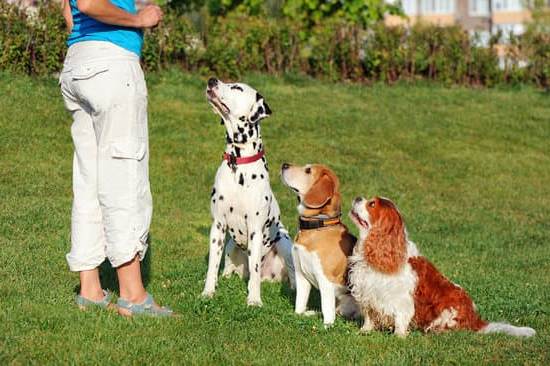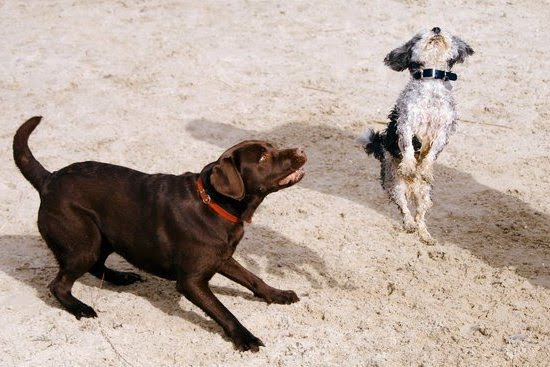Is your furry friend causing chaos at home? Learn how to train a dog to behave and create a harmonious environment for both you and your pet. From understanding behavior problems to using positive reinforcement training, this article will provide you with all the essential tools for successful dog training.
Understanding the importance of training a dog to behave is crucial for a happy and healthy relationship with your pet. Unruly behavior can not only be frustrating but also pose potential risks to both the dog and those around them. Whether it’s excessive barking, jumping, or aggression, addressing these issues through proper training is essential for a well-behaved and socialized canine companion.
In this comprehensive guide, we will delve into the common behavior problems in dogs and explore the benefits of positive reinforcement training. Additionally, we will discuss the role of the owner in establishing leadership and setting boundaries for their furry friend. By following these tips and techniques, you can effectively train your dog to exhibit desirable behavior while strengthening your bond with them.
Understanding Behavior Problems in Dogs
When it comes to training a dog to behave, it is essential to first understand the common behavior problems that dogs may exhibit. By identifying these issues, owners can better address them through proper training techniques and strategies. Some of the most common behavior problems in dogs include:
- Excessive barking: Many dogs bark excessively as a form of communication or in response to certain triggers. This behavior can be disruptive and frustrating for both the owner and those around them.
- Jumping: Dogs often jump on people as a way of greeting or seeking attention. While this behavior may seem harmless, it can be problematic, especially for children or elderly individuals who may be knocked over.
- Aggression: Aggressive behavior in dogs can manifest in various ways, including growling, snarling, snapping, or biting. This type of behavior can pose a serious threat to the safety of others and needs to be addressed promptly.
In order to effectively train a dog to behave, it is crucial for owners to understand the root causes of these behavior problems and implement appropriate training methods to correct them.
Positive reinforcement training has proven to be an effective approach in addressing these behaviors. By rewarding desired behaviors with treats, praise, or toys, dogs learn to associate good behavior with positive outcomes. Additionally, establishing clear boundaries and leadership roles within the household can help curb unwanted behaviors and promote obedience. With patience and consistency, owners can successfully overcome these common behavior issues and raise well-behaved and well-adjusted dogs.
Positive Reinforcement Training
One of the key benefits of positive reinforcement training is that it helps to build a strong and trusting bond between the dog and their owner. By using rewards and praise, the dog learns to associate good behavior with positive outcomes, which can strengthen their relationship with their owner. Additionally, this method helps to create a more enjoyable and rewarding experience for both the dog and their owner during the training process.
Furthermore, positive reinforcement training has been found to be an effective way to modify undesirable behaviors in dogs. Instead of punishing a dog for exhibiting unwanted behavior, positive reinforcement focuses on reinforcing alternative behaviors that are more desirable.
This can lead to long-lasting changes in the dog’s behavior and can help them learn how to behave appropriately in various situations. Through consistent use of positive reinforcement techniques, owners can effectively train their dogs to exhibit better behavior while also promoting a positive and loving relationship between them.
Establishing Leadership
When it comes to training a dog to behave, one of the most crucial aspects is establishing leadership within the household. Dogs are pack animals by nature, and they thrive in an environment where there is a clear leader. As an owner, it is important to take on that role and set boundaries for your dog. This involves demonstrating authority, consistency, and providing clear guidance for your pet.
Setting boundaries for your dog is essential in maintaining a well-behaved pet. This can include rules about where your dog is allowed in the house, how they interact with other pets or family members, and what behaviors are acceptable. By setting these boundaries early on and consistently reinforcing them, you can help your dog understand their place in the household hierarchy.
In addition to setting boundaries, it’s important for owners to establish themselves as leaders through consistent training practices. Positive reinforcement techniques can be used to reward good behavior while addressing any negative behaviors immediately. This teaches your dog that you are in charge while also promoting a positive bond between you and your pet.
| Leadership | Boundaries |
|---|---|
| Demonstrating authority | Setting rules about behavior |
| Consistent training | Role of positive reinforcement |
Basic Obedience Training
When it comes to training a dog to behave, basic obedience training plays a crucial role in shaping a dog’s behavior. Teaching essential commands such as sit, stay, come, and heel not only helps in controlling your dog’s actions but also strengthens the bond between you and your furry companion. Here are some practical tips for effective basic obedience training:
- Start with one command at a time: It’s important to focus on teaching one command at a time to avoid overwhelming your dog. Begin with the sit command as it is relatively easy for most dogs to learn.
- Use positive reinforcement: When your dog follows a command correctly, be sure to reward them with treats, praise, or toys. Positive reinforcement will motivate your dog to repeat the desired behavior.
- Be consistent: Consistency is key in obedience training. Use the same verbal cue and hand signal each time you give a command so that your dog can understand and respond appropriately.
By incorporating these tips into your basic obedience training sessions, you can effectively teach your dog essential commands that will contribute to their overall good behavior. Remember that patience and consistency are crucial throughout the training process, and never use punishment-based methods as they can have negative effects on your dog’s behavior and well-being.
Dealing With Specific Behavior Problems
Understanding Separation Anxiety
Separation anxiety is a common behavior problem in dogs, particularly those who have been adopted from shelters or have experienced changes in their living situations. Dogs with separation anxiety may exhibit destructive behaviors, excessive barking, and even self-harm when left alone. It is important for dog owners to recognize the signs of separation anxiety and address them appropriately.
Addressing Separation Anxiety
One effective technique for addressing separation anxiety in dogs is desensitization. This involves gradually getting the dog used to being alone by leaving them for short periods and gradually increasing the time as they become more comfortable.
Providing engaging toys or treats can also help distract the dog while the owner is away. Additionally, creating a comfortable and safe space for the dog, such as a crate or designated area, can provide them with a sense of security during periods of separation.
Identifying Territorial Aggression
Territorial aggression often manifests as excessive barking, lunging at strangers or other animals, and guarding behavior around the home or certain areas. It is essential for dog owners to understand that territorial aggression can be triggered by various factors such as fear, insecurity, or previous negative experiences.
Managing Territorial Aggression
To address territorial aggression in dogs, it is crucial to establish clear boundaries and provide consistent training to help the dog understand acceptable behavior. Avoid reinforcing aggressive behaviors through punishment and instead focus on positive reinforcement techniques when the dog displays calm and relaxed behavior in situations that would typically trigger aggression. Seeking professional help from a certified dog trainer or behaviorist may also be necessary to address more severe cases of territorial aggression effectively.
Consistency and Patience
One of the most important aspects of training a dog to behave is consistency. Dogs thrive on routine and they learn best when they can predict what is expected of them. This means that all family members must be on the same page when it comes to training.
If one person allows the dog to jump on them while another person reprimands the dog for the same behavior, it will confuse the dog and hinder progress. Consistent commands, rewards, and consequences are crucial for effective training.
Training a dog to behave takes time and patience. It’s important for owners to understand that behavioral changes won’t happen overnight, and some dogs may require more time than others to grasp certain concepts. Pushing a dog too hard or becoming frustrated during training sessions can have a negative impact on the process. Patience is key when it comes to reinforcing positive behaviors and correcting unwanted ones.
It’s important for owners to set realistic expectations when it comes to training their dogs. Not all behaviors can be completely eliminated, and some may require ongoing management.
It’s also important to recognize that there will be setbacks along the way, and that progress may not always be linear. By understanding this and maintaining a consistent yet patient approach, owners can effectively train their dogs to behave in a way that is both realistic and sustainable for long-term success.
Seeking Professional Help
In conclusion, training a dog to behave is a crucial aspect of responsible pet ownership. Understanding the common behavior problems in dogs, using positive reinforcement training, and establishing leadership are all vital components of effective dog training. Basic obedience training, dealing with specific behavior problems such as separation anxiety or territorial aggression, and consistently applying patience throughout the process are also essential.
However, there are instances when behavior issues go beyond an owner’s capabilities. In these cases, seeking professional help from a certified dog trainer may be necessary. Professional dog trainers have the knowledge and experience to address complex behavior problems and can provide owners with the necessary tools and guidance to effectively train their dogs.
It is important for owners to recognize when they need assistance and not feel discouraged when facing challenging behavior issues with their dogs. Seeking professional help does not reflect upon one’s abilities as a pet owner but rather shows dedication to ensuring the well-being of their furry companion. By working with a professional trainer, both the owner and the dog can benefit from specialized expertise, ultimately leading to a happier and well-behaved pet.
Frequently Asked Questions
How Do You Fix a Misbehaving Dog?
Fixing a misbehaving dog requires consistency, patience, and positive reinforcement. Identify the specific behavior that needs to be corrected and then address it with clear commands, redirection, or by rewarding good behavior. It’s important to understand the underlying cause of the misbehavior and address any potential triggers while providing proper exercise, mental stimulation, and socialization.
What Are the 5 Golden Rules of Dog Training?
The 5 golden rules of dog training include establishing leadership, setting clear boundaries and rules, using positive reinforcement, being consistent in commands and expectations, and providing regular exercise and mental stimulation. By following these principles, dog owners can build a strong bond with their pets while effectively shaping their behavior through training.
How Do You Train a Dog With Bad Manners?
Training a dog with bad manners begins by identifying the specific behaviors that need to be addressed. Whether it’s jumping on people, excessive barking, or pulling on the leash during walks, a consistent approach using positive reinforcement is key.
By redirecting negative behaviors into positive ones and providing plenty of praise for good behavior, dogs can learn new manners over time. Professional obedience training may also be beneficial for more challenging cases.

Welcome to the blog! I am a professional dog trainer and have been working with dogs for many years. In this blog, I will be discussing various topics related to dog training, including tips, tricks, and advice. I hope you find this information helpful and informative. Thanks for reading!





